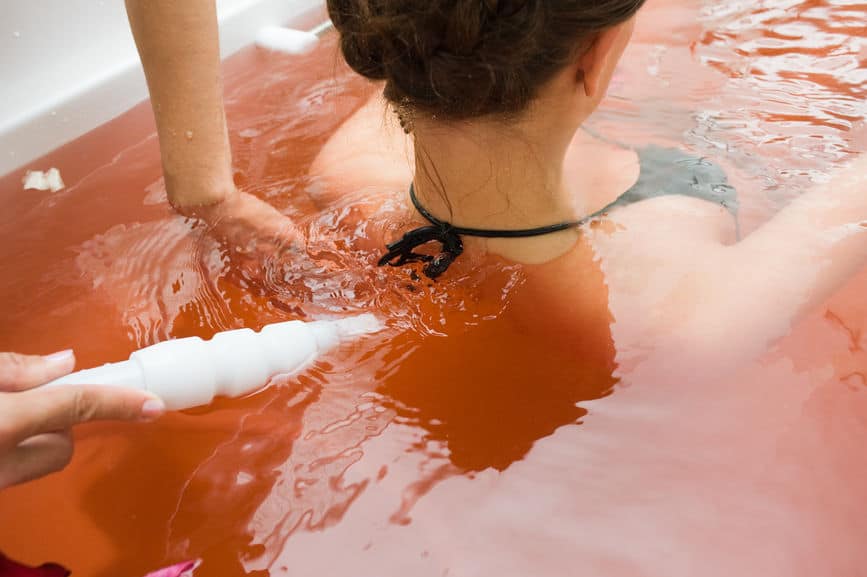

Massage therapy has been steadily gaining legitimacy in the U.S. for its documented capacity to improve health, but most are unaware of how many massage therapy modalities there are to choose from. While Swedish and deep tissue massage are the most common styles, some places offer lesser-known styles of bodywork. Associated with elements that might seem oddly paired with massage therapy, fire massage and water massage are among some of the more unusual types of wellness treatments available.
Fire Massage
Otherwise known as Chinese fire massage, huǒ liáo is a spa treatment from China that can be a frightening concept to those leery of flames. Some establishments may also call huǒ liáo a steam massage. In Tibet, a similar procedure is known as fire dragon therapy.
Although the specifics may vary, Chinese fire massage generally involves placing a cloth soaked in alcohol and a special elixir over the face, back, legs, belly or other problem area. The cloth is ignited and allowed to burn for up to a minute before the therapist smothers the flames with a wet towel. The wet towel may then be used to massage the heated area.
Advocates of huǒ liáo claim its capacity to:
- Eliminate wrinkles
- Relieve joint pain
- Ease insomnia
- Aid digestion
- Curb obesity
- Cure a cold
- Improve conditions that are categorized by Chinese Medicine as cold in temperature
According to Dr. Jacob Teitelbaum, author of Real Cause, Real Cure, (Rodale Books, 2012), “…one explanation [for using fire] is that extreme heat triggers an adrenaline response, which can shift your body’s chemistry, improving some symptoms like indigestion and slow metabolism.” While a traditional Chinese hospital in Changchun, Jilin Province is fighting obesity by using huǒ liáo to burn off fat, this unusual modality is rarely seen in the Western hemisphere. It may be effective, but fire massage’s safety and efficacy have yet to be scientifically documented in a peer-reviewed journal.
Water Massage
A soothing type of massage that takes place in warm, waist-deep water, watsu was developed by Harold Dull back in 1980. The term Watsu® emerged as a combination of water and shiatsu when Dull began applying Zen Shiatsu stretches to students floating in the warm pool at California’s Harbin Hot Springs. According to Dull, “Stretching strengthens muscle and increases flexibility. Warm water like that in the pools at Harbin, which many associate with the body’s deepest states of waking relaxation, proved to be the ideal medium.” Dull established the Worldwide Aquatic Bodywork Association (WABA), which oversees the training of Watsu® practitioners around the world.
A typical Watsu® session takes place in water that is 92 to 94 degrees Fahrenheit, with both the practitioner and the recipient wearing bathing suits. The practitioner performs a series of gentle rocking movements with one hand while the client is secured with the other. In addition to being rocked, clients are also stretched, bent and arched. Because being in the water removes gravity’s effect on the vertebrae, manipulations have little resistance. Watsu® is known to:
- Reduce muscle tension
- Promote a deep state of relaxation
- Increase mobility and flexibility
- Ease stress
- Reduce pain
- Improve sleep
- Release pent-up emotions
According to a South Korean study published in a June 2009 edition of Physiotherapy Research International, Watsu® was helpful in controlling spasticity and improving ambulatory function of patients with hemiparesis after a stroke. Watsu® requires a special type of pool; thus it is a relatively unusual service. Most prevalent in the Western U.S., this unique type of bodywork is currently offered in more than 40 countries around the world.
Massage using the elements of fire and water may seem strange at first, but each has its own strength. The warming property of fire can be energizing – activating both circulation and metabolism, potentially providing aid to several health and beauty concerns. The weightlessness provided by water is emotionally and physically relaxing while simultaneously providing a medium to easily and gently manipulate constricted body tissues. Huǒ liáo and Watsu® are unusual and may even seem bizarre, but both styles of bodywork offer a unique perspective on supporting health and wellness.











